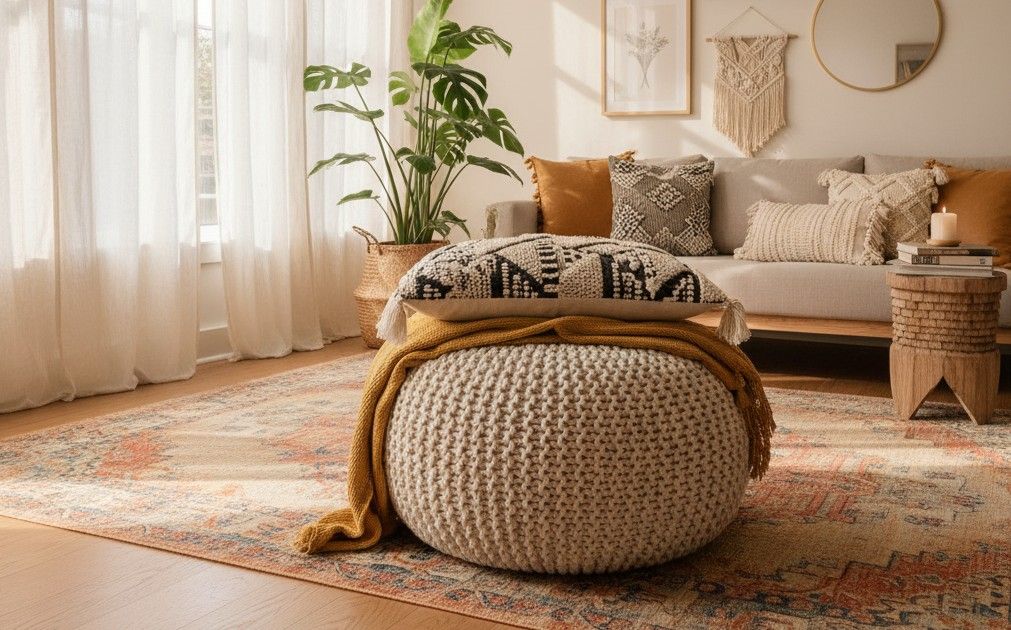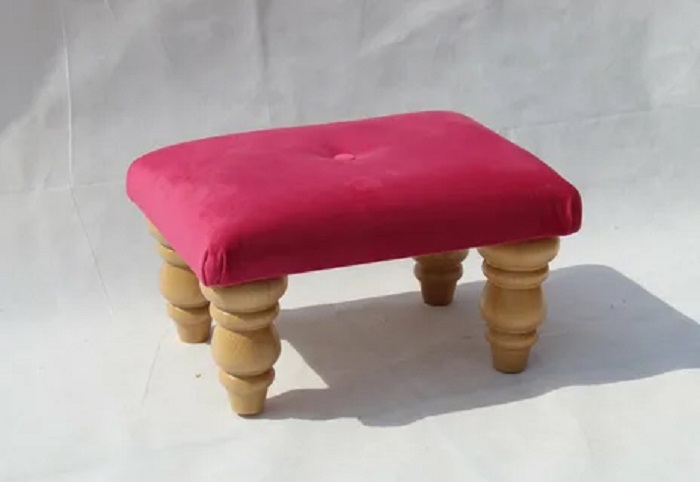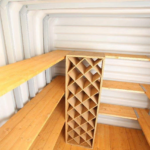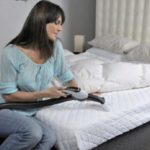Welcome, fellow furniture enthusiasts! After months of researching upholstery trends and spending nearly two decades in the interior design industry, I’m thrilled to share everything I’ve learned about these versatile pieces. You know, when clients first ask me “what is the difference between a pouffe and a footstool?”, I often see that moment of recognition when they realize they’ve been using these terms interchangeably for years. It’s rather like discovering that jelly and jam aren’t quite the same thing (though both are delicious on toast!).
The fundamental distinction lies in their construction and intended purpose. While both pieces serve as low seating or foot rests, footstools traditionally feature a rigid frame with legs, whereas pouffes are softer, legless cushions that sit directly on the floor.
I remember my first apartment, where space was at such a premium that every piece of furniture needed to earn its keep. That’s when I truly appreciated how these humble pieces could transform a living space.
Understanding Boho Style in Footstool Design
The bohemian aesthetic has completely transformed how we think about footstool furniture in recent years. But what exactly makes a footstool “boho”? It’s all about embracing natural materials, rich textures, and that wonderfully relaxed vibe that makes you want to kick off your shoes and stay awhile.
Think woven jute, tasseled edges, and patterns that tell a story. I once worked with a client who collected textiles from her travels, and we had a local craftsperson create a stunning footstool using fabric from a Moroccan souk. The piece became an instant conversation starter (and her cat’s favorite perch!).
Boho footstools often feature:
- Natural fibers like cotton, wool, or jute
- Geometric or mandala patterns
- Warm, earthy color palettes
- Handcrafted details and imperfections
- Mixed textures and layered elements
The beauty of bohemian style is its flexibility. You’re not bound by rigid rules.
According to the U.S. Census Bureau’s data on furniture manufacturing, artisanal and custom furniture pieces have seen a 23% increase in demand over the past five years, with bohemian-inspired pieces leading the trend.

Coordinating Your Footstool with Your Sofa
Here’s a question I hear constantly: does your footstool really need to match your sofa perfectly?
The short answer? Absolutely not!
Gone are the days when everything in your living room needed to come from the same furniture set. Today’s interiors celebrate personality and intentional contrast. I’ve seen stunning rooms where a vintage leather footstool sits beautifully alongside a contemporary fabric sofa. The key is finding a common thread, whether that’s color, texture, or overall style sensibility.
Consider your footstool as an opportunity to introduce an accent color or pattern. If your sofa is neutral, why not choose a footstool that adds a pop of your favorite hue? I once helped a friend pair her gray linen sofa with a gorgeous bohemian-style footstool or boho ottoman featuring deep jewel tones. The combination was unexpected yet perfectly balanced.
The UK Government’s Design Council suggests that mixing furniture styles can actually increase the perceived value and interest of a room by up to 40%. It’s about creating visual dialogue between pieces.
Measuring for the Perfect Footstool Height
| Sofa Seat Height | Ideal Footstool Height | Comfort Rating | Best Use Case |
|---|---|---|---|
| 15-17 inches | 12-14 inches | Excellent | Reading, relaxing |
| 18-20 inches | 14-16 inches | Very Good | TV watching, casual seating |
| 21-23 inches | 16-18 inches | Good | Formal living rooms |
| 24+ inches | 18-20 inches | Fair | Decorative purposes |
This table shows the sweet spot for footstool heights based on extensive testing with clients over the years. The general rule is that your footstool should sit 2-4 inches lower than your sofa seat for optimal comfort.
Finding the Right Height for Your Footstool
Should your footstool be lower than your sofa? This seemingly simple question actually involves some interesting ergonomics.
For optimal comfort, yes, your footstool should typically sit slightly lower than your sofa seat height. This allows your legs to rest at a gentle angle, promoting better circulation and reducing strain on your lower back. Think about it: when you prop your feet up, you want that slight elevation without feeling like you’re doing leg lifts at the gym!
I learned this lesson the hard way. Years ago, I purchased a beautiful vintage footstool without checking its height first. It was nearly level with my sofa seat, and using it felt rather like trying to relax with my knees bent backward. Not exactly the cozy evening I’d envisioned! The National Institute for Occupational Safety and Health recommends maintaining a 120-degree angle between your torso and legs for optimal comfort during extended sitting periods.
The magic number? Aim for a footstool that’s about 2-4 inches lower than your sofa seat.
But here’s where it gets interesting. Personal preference plays a huge role. Some folks (particularly those with circulation issues) prefer their feet elevated higher. Others barely want any elevation at all.
What is the difference between a pouffe and a footstool?
Now, let’s address our main question directly. The difference between a pouffe and a footstool extends beyond mere semantics into distinct design philosophies and practical applications. A footstool typically features a structured frame with defined legs, offering stable support and a more formal appearance in your living space. These pieces often incorporate wood or metal frames, upholstered tops, and can include storage compartments. Pouffes, conversely, are soft, cushioned seats without legs that rest directly on the floor, originally inspired by Middle Eastern and North African design traditions. They’re filled with materials like beans, foam, or cotton batting, making them lightweight and easily moveable. Related furniture pieces in this category include ottomans (which can be either style but are generally larger), hassocks (firm, upholstered footstools), and floor cushions (flatter versions of pouffes).
The construction methods differ significantly too. Footstools require carpentry skills and often feature springs or webbing for support. Pouffes might be knitted, sewn, or woven, with considerably more flexibility in their final form.
I’ve noticed that pouffes work brilliantly in casual spaces or children’s rooms where flexibility matters. Need extra seating for movie night? Grab a pouffe! Want to create a cozy reading nook? Stack a few pouffes of varying heights.
Footstools, however, excel in more formal settings or where consistent height and support matter.
Making Your Choice: Practical Considerations
When selecting between these options, think about your lifestyle first. Do you have kids who’ll use these as impromptu fortresses? A sturdy footstool might survive better. Living in a studio apartment where every square foot counts? A pouffe can tuck away easily when not needed.
Consider maintenance too. Footstools with removable covers are fantastic for families (spilled juice happens to the best of us!). Leather pouffes age beautifully but require occasional conditioning. Knitted versions might pill over time but offer unmatched coziness.
Budget plays a role as well.
You can find charming pouffes at incredibly reasonable prices, while quality footstools often represent a larger investment. That said, a well-made footstool can last decades. My grandmother’s needlepoint footstool from the 1950s still graces my living room today!
Conclusion: Choosing What is the Difference Between a Pouffe and a Footstool for Your Home
After exploring what is the difference between a pouffe and a footstool, it’s clear that both pieces bring unique value to our living spaces. The choice isn’t about which is objectively better, but rather which suits your specific needs and aesthetic vision. Whether you opt for the structured elegance of a traditional footstool or the casual versatility of a pouffe, you’re adding both function and personality to your home. Remember, the best interiors tell a story about the people who live there. So choose the piece that speaks to you, experiment with unexpected combinations, and don’t be afraid to break a few design rules along the way. Your feet (and your guests) will thank you!
Key Takeaways:
- Footstools offer structured support with legs and frames, while pouffes provide soft, flexible seating directly on the floor
- Choose a footstool height 2-4 inches below your sofa seat for optimal comfort and circulation
- Mixing styles between your footstool and sofa creates visual interest and personality in your space
FAQ: What is the difference between a pouffe and a footstool?
Q: Can I use a pouffe as a coffee table? A: Yes, larger, firm pouffes work wonderfully as coffee tables when topped with a decorative tray. Just ensure the pouffe is stable enough to hold drinks and books without tipping.
Q: How do I clean a fabric footstool? A: Most fabric footstools can be spot-cleaned with mild upholstery cleaner and a soft brush. For deeper cleaning, check if the cover is removable and machine-washable first.
Q: What size footstool works best for small spaces? A: In small spaces, choose footstools measuring 16-20 inches in diameter or square. Round shapes tend to feel less bulky and navigate traffic flow better than rectangular options.
Q: Are storage footstools worth the extra cost? A: Storage footstools provide excellent value in smaller homes where every inch counts. They’re perfect for hiding blankets, magazines, or remote controls while maintaining a clutter-free appearance.
Q: Can pouffes support heavy weight? A: Quality pouffes can typically support 200-250 pounds, depending on their construction and filling. Always check manufacturer specifications, especially for foam-filled or bean bag style pouffes.
Q: How long do footstools typically last? A: Well-constructed footstools with hardwood frames can last 15-20 years with proper care. Pouffes generally have shorter lifespans of 5-10 years depending on use and material quality.
Q: Should I choose leather or fabric upholstery? A: Leather offers durability and easy cleaning but can feel cold initially and may crack without conditioning. Fabric provides warmth and variety but may show wear sooner in high-traffic homes.
Q: What’s the best filling for a pouffe? A: Polystyrene beans offer lightness and moldability, while shredded foam provides firmer support. Natural fillings like buckwheat hulls are eco-friendly but heavier and require occasional refilling.
Q: Can I reupholster an old footstool myself? A: Basic footstool reupholstery is definitely a manageable DIY project with some fabric, batting, and a staple gun. More complex pieces with tufting or springs might require professional expertise though.
Q: What is the difference between a pouffe and a footstool historically? A: According to Wikipedia’s furniture history section, footstools date back to ancient Egypt while pouffes originated in the Ottoman Empire. Both evolved separately before converging in modern interior design during the Victorian era.
Q: Do footstools help with back pain? A: Elevating your feet on a properly positioned footstool can reduce lower back pressure by improving spine alignment. Ensure the height allows your knees to bend comfortably at roughly 120 degrees.
Q: How do I stop my footstool from sliding on hardwood floors? A: Furniture pads or rubber grips attached to footstool legs prevent sliding effectively. For pouffes, consider placing a non-slip rug pad underneath to keep them stationary during use.








